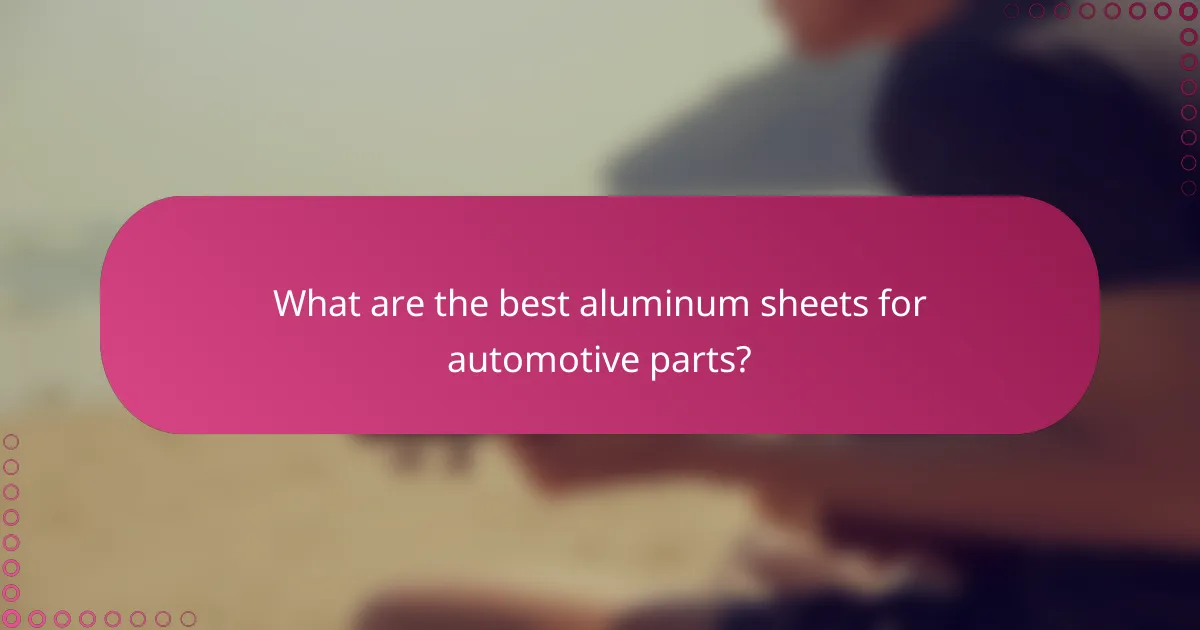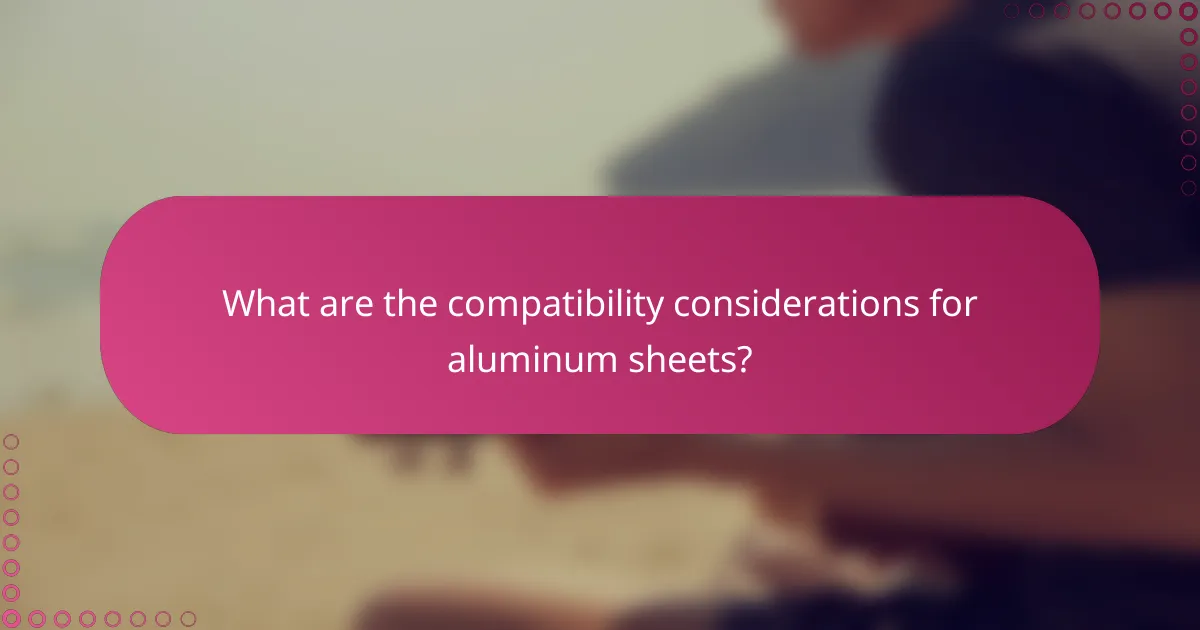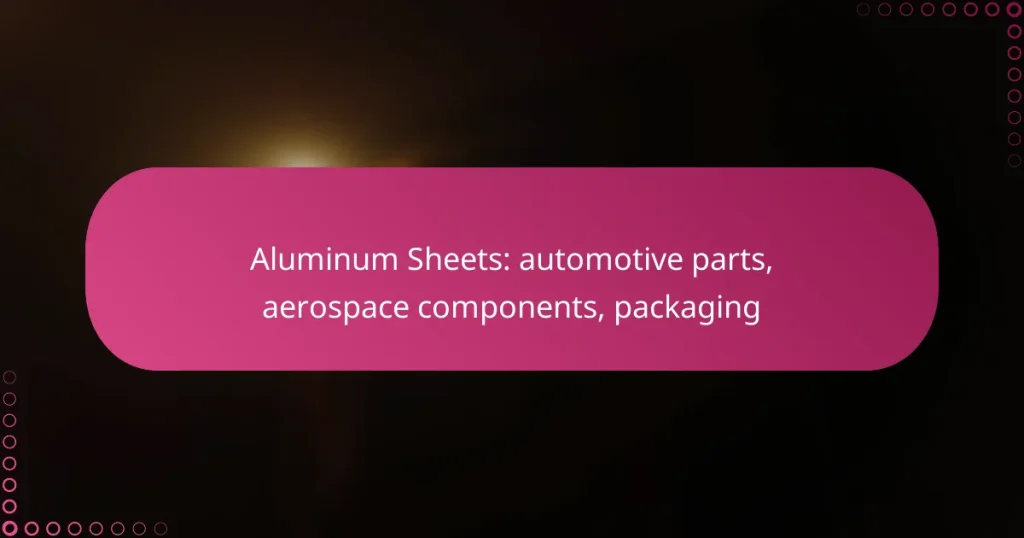Aluminum sheets are versatile materials widely used in various industries, including automotive, aerospace, and packaging. In automotive applications, specific alloys provide essential properties such as strength and corrosion resistance for different vehicle components. For aerospace, selecting the right aluminum sheet involves meeting stringent requirements for weight and durability. Additionally, in packaging, aluminum sheets offer lightweight and durable solutions that ensure excellent barrier protection for products ranging from food to pharmaceuticals.

What are the best aluminum sheets for automotive parts?
The best aluminum sheets for automotive parts depend on the specific application, with different alloys offering unique properties. Key factors include strength, corrosion resistance, and formability, which are essential for various components in vehicles.
Aluminum 6061 for structural components
Aluminum 6061 is widely used for structural components in automotive applications due to its excellent strength-to-weight ratio and good corrosion resistance. This alloy is often chosen for parts like frames, brackets, and supports, where durability is crucial.
When selecting Aluminum 6061, consider its availability in various tempers, such as T6, which enhances its mechanical properties. It is also easily weldable, making it a practical choice for complex assemblies.
Aluminum 5052 for fuel tanks
Aluminum 5052 is ideal for manufacturing fuel tanks because of its outstanding corrosion resistance and formability. This alloy can withstand harsh environments, making it suitable for both gasoline and diesel applications.
When using Aluminum 5052, ensure that the thickness meets regulatory standards for fuel containment, typically around 1.5 to 3 mm. Its ability to be easily shaped and welded allows for efficient production of custom tank designs.
Aluminum 3003 for body panels
Aluminum 3003 is commonly used for body panels due to its good workability and moderate strength. This alloy is lightweight and provides excellent corrosion resistance, making it suitable for exterior applications.
For body panels, Aluminum 3003 is often available in thicknesses ranging from 0.8 to 2.0 mm. Its ease of fabrication allows for intricate designs, but be cautious of its lower strength compared to other alloys, which may limit its use in high-impact areas.

How to choose aluminum sheets for aerospace components?
Choosing aluminum sheets for aerospace components involves selecting materials that meet specific strength, weight, and corrosion resistance requirements. Key considerations include the intended application, regulatory standards, and the mechanical properties of the aluminum alloy.
Aluminum 7075 for high-strength applications
Aluminum 7075 is known for its exceptional strength-to-weight ratio, making it ideal for high-stress aerospace applications. This alloy is often used in aircraft structures where performance and durability are critical.
When selecting 7075 aluminum sheets, consider the tempering process, as it significantly affects the material’s properties. Common tempers include T6, which offers maximum strength, and T73, which provides improved stress corrosion resistance.
Keep in mind that while 7075 is strong, it can be more challenging to machine compared to other alloys. Ensure that your fabrication processes are compatible with this material to avoid potential issues.
Aluminum 2024 for aircraft structures
Aluminum 2024 is another popular choice for aircraft structures, particularly in applications requiring good fatigue resistance and weldability. This alloy is often used in the fuselage and wing structures of aircraft.
When selecting 2024 aluminum sheets, pay attention to the temper, as different tempers can affect the alloy’s performance. The T3 temper is commonly used for its balance of strength and workability, while T4 offers better corrosion resistance.
Be aware that 2024 aluminum is less resistant to corrosion than some other alloys, so consider protective coatings or treatments to enhance durability in harsh environments.

What are the advantages of aluminum sheets in packaging?
Aluminum sheets offer several advantages in packaging, including lightweight properties, durability, and excellent barrier protection. These characteristics make them ideal for a variety of applications, from food containers to pharmaceutical packaging.
Lightweight and durable
Aluminum sheets are significantly lighter than many other materials, which reduces shipping costs and makes handling easier. Despite their light weight, they maintain high strength and can withstand various stresses, making them suitable for protective packaging.
This combination of lightweight and durability is particularly beneficial in industries where reducing weight can lead to cost savings and improved efficiency, such as in food and beverage packaging.
Corrosion resistance
One of the key benefits of aluminum sheets is their natural resistance to corrosion. This property is crucial for packaging applications, as it helps protect contents from moisture and environmental factors that could lead to spoilage.
Aluminum’s corrosion resistance allows it to maintain its integrity over time, making it a reliable choice for packaging products that require a long shelf life, such as canned goods and beverages.
Recyclability
Aluminum sheets are highly recyclable, which is an important consideration in today’s environmentally conscious market. Recycling aluminum requires significantly less energy compared to producing new aluminum, making it a sustainable option for packaging.
Many packaging companies are now focusing on using recycled aluminum, which not only reduces waste but also appeals to consumers who prioritize eco-friendly products. This trend aligns with global efforts to minimize environmental impact and promote sustainability in packaging materials.

What are the key specifications for aluminum sheets?
The key specifications for aluminum sheets include thickness, dimensions, alloy types, and grades, which are crucial for determining their suitability for various applications such as automotive parts, aerospace components, and packaging. Understanding these specifications helps manufacturers select the right materials to meet performance and regulatory requirements.
Thickness and dimensions
Aluminum sheets typically range in thickness from about 0.2 mm to 6 mm, with common dimensions being 1,220 mm x 2,440 mm or 1,500 mm x 3,000 mm. The thickness chosen often depends on the application; for instance, thicker sheets are preferred for structural components, while thinner sheets are suitable for packaging.
When selecting aluminum sheets, consider the specific requirements of your project, such as weight constraints and strength needs. It’s essential to ensure that the dimensions fit within the manufacturing processes, such as cutting and forming, to avoid waste and inefficiencies.
Alloy types and grades
Aluminum sheets come in various alloy types, primarily categorized into series based on their main alloying elements. Common series include 1000 (pure aluminum), 3000 (manganese), 5000 (magnesium), and 6000 (magnesium and silicon), each offering different properties like corrosion resistance, weldability, and strength.
Choosing the right alloy grade is vital for achieving the desired performance. For instance, 6061 aluminum is often used in aerospace applications due to its excellent mechanical properties, while 3003 is commonly used for packaging due to its good workability. Always consult material specifications to ensure compliance with industry standards and regulations.

What are the compatibility considerations for aluminum sheets?
Compatibility considerations for aluminum sheets include factors like welding methods, coating options, and the intended application. Understanding these aspects ensures optimal performance and longevity in automotive, aerospace, and packaging uses.
Welding compatibility
When welding aluminum sheets, it is crucial to select the appropriate welding technique, as different alloys respond differently. Common methods include MIG and TIG welding, with MIG being suitable for thicker sheets and TIG providing better control for thinner materials.
Consider the alloy’s characteristics, such as strength and corrosion resistance, when choosing a welding method. For instance, 5000 series alloys are often preferred for marine applications due to their excellent corrosion resistance, while 6000 series alloys are commonly used in structural applications.
Coating and finishing options
Aluminum sheets can be coated or finished in various ways to enhance their properties, including anodizing, powder coating, and painting. Anodizing increases corrosion resistance and can improve aesthetic appeal, while powder coating offers a durable finish that is resistant to chipping and fading.
When selecting a coating, consider the end-use environment. For example, automotive parts may require finishes that withstand high temperatures and exposure to chemicals, while packaging applications might prioritize food safety and recyclability. Always check for compliance with relevant regulations, especially in food and medical applications.

What are the shipping and return policies for aluminum sheets?
Shipping and return policies for aluminum sheets vary by supplier but generally include options for bulk orders and specific guidelines for damaged products. Understanding these policies can help ensure a smooth purchasing experience.
Shipping options for bulk orders
When ordering aluminum sheets in bulk, suppliers typically offer various shipping options, including standard ground, expedited, and freight shipping. The choice of shipping method can affect delivery times and costs, with freight often being more economical for larger quantities.
Consider factors such as delivery speed and budget when selecting a shipping option. For instance, standard ground shipping may take several days, while expedited services can reduce delivery time to one or two days, albeit at a higher cost.
Return policies for damaged products
Return policies for damaged aluminum sheets usually allow for returns within a specified period, often ranging from 30 to 60 days. Most suppliers require that customers report any damage upon receipt to initiate a return process.
To avoid complications, inspect the sheets immediately upon delivery and document any damage with photos. Familiarize yourself with the specific return procedures of your supplier, as some may require the original packaging or specific forms to be filled out for returns.

What are the emerging trends in aluminum sheet applications?
Emerging trends in aluminum sheet applications focus on lightweighting, sustainability, and advanced manufacturing techniques. Industries such as automotive, aerospace, and packaging are increasingly adopting aluminum sheets due to their strength-to-weight ratio and recyclability.
Lightweight materials in electric vehicles
Lightweight aluminum sheets are crucial in the design of electric vehicles (EVs) as they help improve efficiency and range. By reducing the overall weight of the vehicle, manufacturers can enhance battery performance and extend driving distance on a single charge.
Aluminum’s high strength-to-weight ratio allows for thinner sheets that still provide the necessary structural integrity. This is particularly important in components like body panels, chassis, and battery enclosures, where every kilogram saved can significantly impact the vehicle’s performance.
When selecting aluminum for EV applications, consider factors such as corrosion resistance and formability. Common grades used include 5000 and 6000 series alloys, which offer a balance of strength and workability, making them suitable for various automotive parts.


